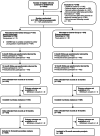The clinical and cost effectiveness of a STAndardised DIagnostic Assessment for children and adolescents with emotional difficulties: the STADIA multi-centre randomised controlled trial
- PMID: 39775729
- PMCID: PMC12062850
- DOI: 10.1111/jcpp.14090
The clinical and cost effectiveness of a STAndardised DIagnostic Assessment for children and adolescents with emotional difficulties: the STADIA multi-centre randomised controlled trial
Abstract
Background: Standardised Diagnostic Assessment tools, such as the Development and Well-Being Assessment (DAWBA), may aid detection and diagnosis of emotional disorders but there is limited real-world evidence of their clinical or cost effectiveness.
Methods: We conducted a multicentre, two-arm parallel group randomised controlled trial in eight large National Health Service Trusts in England providing multidisciplinary specialist Child and Adolescent Mental Health Services (CAMHS). Participants (5-17 year-olds with emotional difficulties referred to CAMHS) were randomly assigned (1:1), following referral receipt, to either receive the DAWBA and assessment-as-usual (intervention group) or assessment-as-usual (control group). Data were self-reported by participants (parents and/or young person, depending on age) at baseline, 6- and 12-month post-randomisation and collected from clinical records up to 18 months post-randomisation. The primary outcome was a clinician-made diagnosis decision about the presence of an emotional disorder within 12 months of randomisation.
Trial registration: ISRCTN15748675.
Results: In total, 1,225 children and young people (58% female sex) were randomised (615 intervention; 610 control). Adherence to the intervention (full/partial completion) was 80% (494/615). At 12 months, 68 (11%) participants in the intervention group received an emotional disorder diagnosis versus 72 (12%) in the control group (adjusted risk ratio (RR) 0.94 [95% CI 0.70, 1.28]). The intervention was not cost effective. There was no evidence of any differences between groups for service-related or participant-reported secondary outcomes, for example, CAMHS acceptance of the index referral (intervention 277 (45%) versus control 262 (43%); RR: 1.06 [95% CI: 0.94, 1.19]) was similar between groups.
Conclusions: As delivered in this pragmatic trial, we found no evidence for the effectiveness or cost effectiveness of using a Standardised Diagnostic Assessment tool in aiding the detection of emotional disorders or clinical outcomes in clinically referred children and young people. Despite regular efforts to encourage clinicians to view the DAWBA report and consider its findings as part of assessment and diagnosis, we did not collect data on usage and therefore cannot confirm the extent to which clinicians did this. As a pragmatic trial that aimed to test the effectiveness of incorporating the DAWBA into usual practice and clinical care, our study found that, in the format as delivered in this trial, there was no impact on diagnosis or clinical outcomes.
Keywords: Child and Adolescent Mental Health Services (CAMHS); RCT; STADIA; diagnosis; emotional disorders; health economic evaluation; standardised diagnostic assessment.
© 2024 The Author(s). Journal of Child Psychology and Psychiatry published by John Wiley & Sons Ltd on behalf of Association for Child and Adolescent Mental Health.
References
-
- Clayborne, Z.M. , Varin, M. , & Colman, I. (2019). Systematic review and meta‐analysis: Adolescent depression and long‐term psychosocial outcomes. Journal of the American Academy of Child and Adolescent Psychiatry, 58, 72–79. - PubMed
-
- Craddock, N. , Antebi, D. , Attenburrow, M.‐J. , Bailey, A. , Carson, A. , Cowen, P. , et al. (2008). Wake‐up call for British psychiatry. British Journal of Psychiatry, 193, 6–9. - PubMed
Publication types
MeSH terms
Grants and funding
LinkOut - more resources
Full Text Sources
Research Materials


